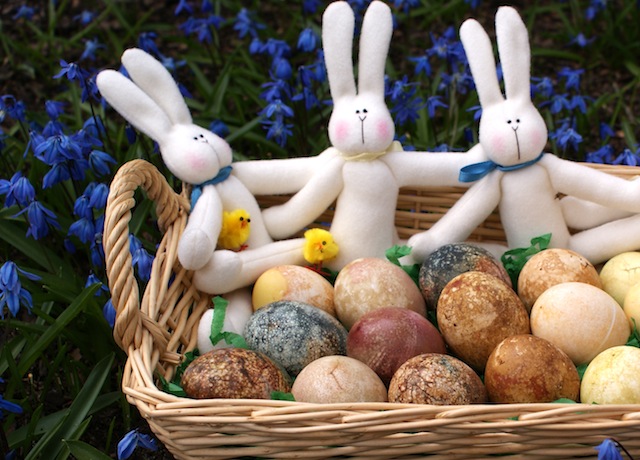Easter is not a tradition in my family, so growing up I did not have many opportunities to dye Easter eggs, except one or two times with a friend. In light of all the recent news about the detrimental effects of artificial food colorings (get more information about the latest research on food dyes here and here), I thought I would experiment with homemade, natural dyes. Instead of exposing your children to the toxins in artificial colorings through their skin (yes, the chemicals go right through the skin into the body), you can use these natural dyes instead.
As you can see, the final product came out different than the typical dyed egg, but interesting none the less. At first, I thought it was a failure, but as the eggs were soaking in the dyes I saw textures and mosaics forming that spoke of nature and the myriad variations that may be found. As there are so many possible materials from the natural world that could be used, a list would be quite long. Instead, I will tell you what I used and when you try these eggs with your children, make a game of it and challenge them to think of materials they could use from your pantry or the garden. Please leave a comment and let me know what worked for you, and have fun!
Naturally-Dyed Easter Eggs
WHAT YOU WILL NEED
washable tablecloth, mugs or deep bowls, forks, spoons
white vinegar
hard-boiled eggs
egg cartoon
INSTRUCTIONS
- Cover workstation with the tablecloth
- For each color, put the material into a mug or bowl
- Mash up the materials with a fork (or boil if appropriate)
- Adults should pour hot water into the mugs or bowls
- Add 1 Tablespoon of white vinegar to each mug (try to get organic vinegar as it is made from corn)
- If the bowl is larger use more vinegar (I think the vinegar is what creates the mottled effect)
- The children can lower the egg into the mug using a spoon
- Let soak. I soaked mine overnight as the natural dyes need a long time to adhere to the egg
- If you plan to eat the eggs, soak them overnight in the refrigerator
- Try using rubber-bands, and/or wax crayons to create patterns if so desired
- After you decide the color is right, let them dry in the egg cartoon
- They will be dull — remember, natural dyes will not be as vibrant as fake dyes
- When dried (the next day), you may wipe them gently with mineral oil or cooking oil to give them a beautiful sheen
COLOR PREPARATIONS
- blue: blueberry juice from frozen blueberries that have been thawed
- maroon: beet juice from steamed beets
- grey/blue: grape juice
- yellow: turmeric
- red: paprika
- brown: clove
- green: boiled spinach (this did not work very well)
